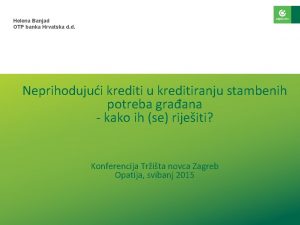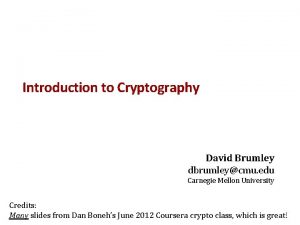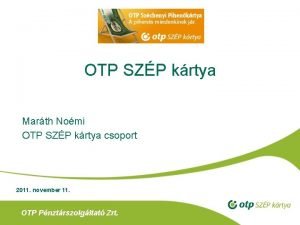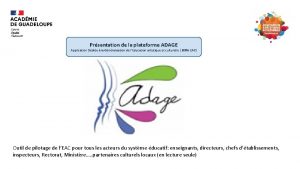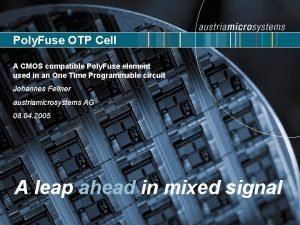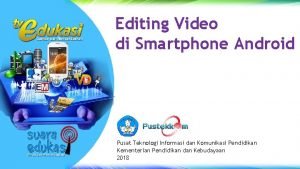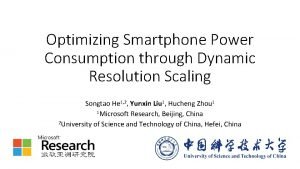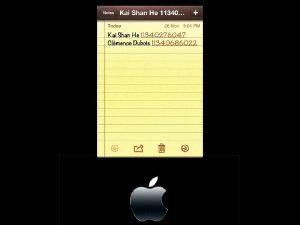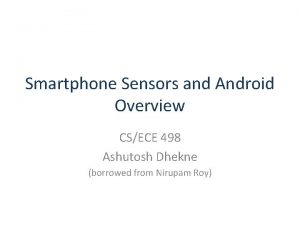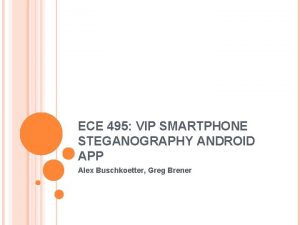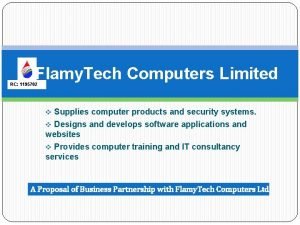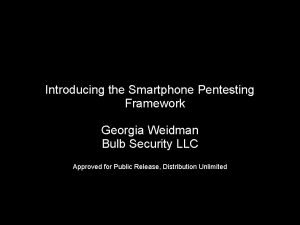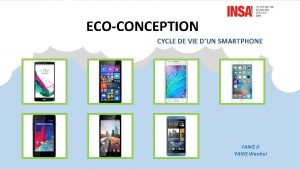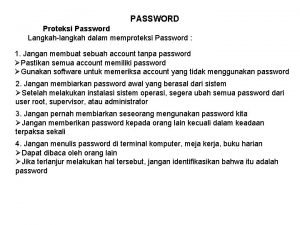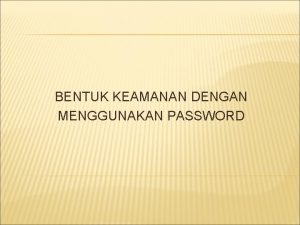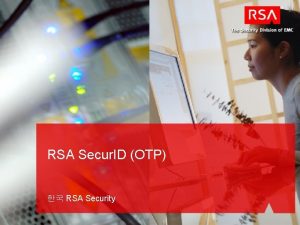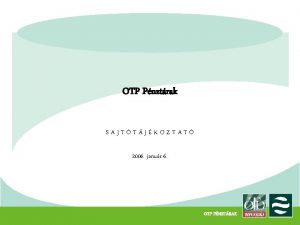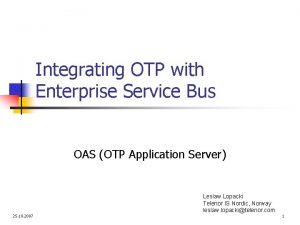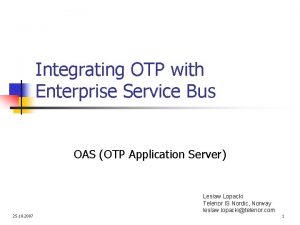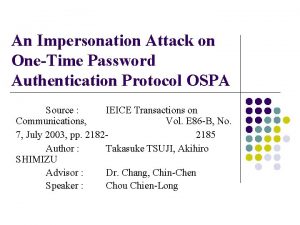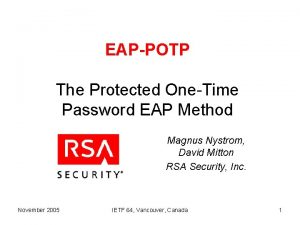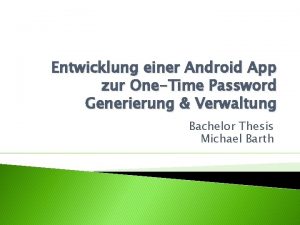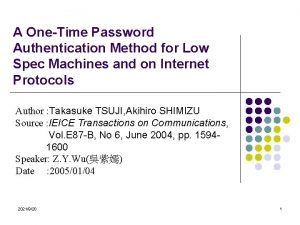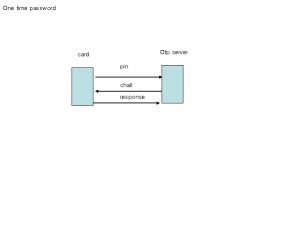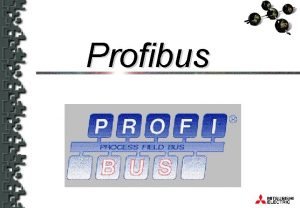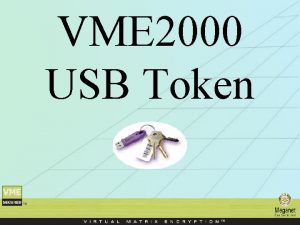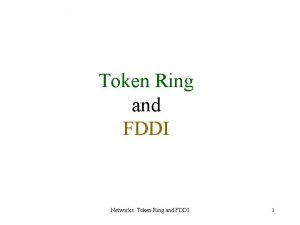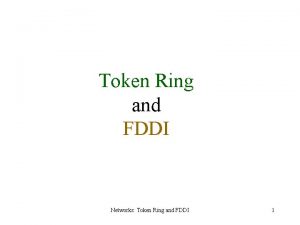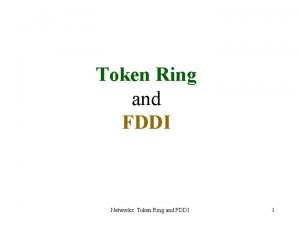Trust OTP Smartphone as OneTime Password Token Instructor








![Trust. Zone-related work ■ Trust. ICE (Sun et al. [1]) ■ ■ Se. CRe. Trust. Zone-related work ■ Trust. ICE (Sun et al. [1]) ■ ■ Se. CRe.](https://slidetodoc.com/presentation_image_h/1fad52431abeaf1c4d4a70576a6acfc9/image-9.jpg)
















- Slides: 25

Trust. OTP: Smartphone as One-Time Password Token Instructor: Kun Sun, Ph. D.

Outline ■ ■ ■ Introduction Background Design & Implementation Evaluation Related work Summary

Outline ■ ■ ■ Introduction Background Related work Design & Implementation Evaluation Summary

One-time Password (OTP) ■ A password that is valid for only one login session or transaction ■ ■ Not vulnerable to replay attacks Widely used in Two-factor Authentication HOTP (Hash-based) & TOTP (Time-based) Hardware Token & Software APP

Existing Solutions ■ Hardware-based ■ ■ ■ Software-based ■ ■ ■ RSA Secur. ID Yubikey Google Authenticator Mc. Afee One-time Password Limitations ■ Hardware: not flexible ■ ■ Unprogrammable Software: not secure ■ Vulnerable to external attacks

Outline ■ ■ ■ Introduction Background Related work Design & Implementation Evaluation Summary

Trust. Zone Background ■ ■ ■ Trust. Zone ü A system-wide approach ü Two isolated execution domains: secure domain and normal domain TZIC (Trust. Zone Interrupt Controller) ü Secure interrupt--FIQ ü Non-secure interrupt-IRQ GPIO (General Purpose I/O) 7

Outline ■ ■ ■ Introduction Background Related work Design & Implementation Evaluation Summary
![Trust Zonerelated work Trust ICE Sun et al 1 Se CRe Trust. Zone-related work ■ Trust. ICE (Sun et al. [1]) ■ ■ Se. CRe.](https://slidetodoc.com/presentation_image_h/1fad52431abeaf1c4d4a70576a6acfc9/image-9.jpg)
Trust. Zone-related work ■ Trust. ICE (Sun et al. [1]) ■ ■ Se. CRe. T (Jang et al. [2]) ■ ■ ■ Real-time kernel protection in the normal domain Trust. Dump (Sun et al. [4]) ■ ■ Secure channel between secure domain and normal application Hypervision (Azab et al. [3]) ■ ■ Isolated Computing Environment in the normal domain Reliable Memory Acquisition of the mobile OS Smartphone as location verification token for payments (Marforio et al. [5]) Trusted Language Runtime for trusted applications in the secure domain (Santos et al. [6])

Outline ■ ■ ■ Introduction Background Related work Design & Implementation Evaluation Summary

One-time Password on Smartphone ■ ■ Integrate physical tokens into smartphone Requirements: ■ Security ■ ■ ■ Malicious mobile OS cannot compromise the keying material in the one-time password (OTP) generator It cannot read the OTP Reliability and Availability ■ ■ ■ OTP works even if mobile OS crashes Trusted inputs (e. g. , clock time) for the OTP generator Trusted display 11

Trust. Zone-based Solution ■ ARM Trust. Zone Technology ■ Two isolated execution environments ■ Mobile OS cannot access the disk, memory, CPU states of the OTP generator. ■ A secure clock for OTP generator ■ A self-contained display and touchscreen. 12

Trust. OTP Framework ■ In the Secure domain ■ Shard I/O device with the Rich OS ■ Reliable switch between domains

Boot Sequence ■ Secure storage ■ ■ Memory Isolation ■ ■ ■ Micro. SD card Watermark Mechanism TZASC (Trust. Zone Address Space Controller) Secure boot ■ ■ ■ Secure bootloader Non-secure bootloader Rich OS

Trust. OTP Trigger ■ Reliable switch ■ Non-maskable interrupt (NMI) ■ ■ Secure interrupt (FIQ) ■ ■ The Rich OS cannot block or intercept The Rich OS cannot manipulate Interrupt source (Configurable) ■ ■ Physical button Timer

OTP Generation ■ Hash-based One-time Password (HOTP) ■ ■ ■ Event triggered Key & Counter Time-based One-time Password (TOTP) ■ ■ Time synchronized Key & Clock

OTP Display ■ Secure I/O ■ ■ ■ Display: IPU (Image Processing Unit)+LCD Input: 4 -wire resistive touchscreen User-friendly manner ■ ■ ■ Rich OS and Trust. OTP run concurrently Watchdog timer 1. 5 seconds / cycle (Through experiment) ■ ■ 0. 5 second for display 1 second for input 2~3 numbers

Security Analysis ■ Information Leakage ■ ■ ■ Control Flow Tampering ■ ■ ■ Generated OTPs Shared Keys Code Integrity Execution Integrity (Interrupt) Denial-of-Service ■ ■ ■ Switch between domains Static & dynamic code Display

Outline ■ ■ ■ Introduction Background Related work Design & Implementation Evaluation Summary

Trust. OTP Performance ■ ■ Before OTP display (60. 48 ms) Step Operation Time (ms) 1 Domain Switching 0. 002 2 Context Saving 0. 0006 3 TOTP/HOTP Generation 0. 048/0. 044 4 Background Matching 49. 85 5 OTP Drawing 8. 029 6 IPU Check 2. 22 7 Framebuffer Replacement 0. 28 After OTP display (7. 52 ms) Step Operation Time (ms) 1 Flushing IPU & Rich OS Recovery 7. 47 2 Domain Switching 0. 05

Impact on the Rich OS ■ ■ Rich OS vs. Trust. OTP Antutu ■ ■ ■ CPU & RAM I/O devices Vellamo

Power Consumption ■ Rich OS ■ ■ Trust. OTP Running ■ ■ Average=2, 128 m. W Average=2, 230 m. W Trust. OTP without Display

Outline ■ ■ ■ Introduction Background Related work Design & Implementation Evaluation Summary

Summary ■ Trust. OTP: Hardware-assisted OTP Token ■ ■ ■ Security (Confidentiality, Integrity, Availability) Flexibility (Various and multiple ICEs) Little Impact on the Rich OS ■ ■ No need to modify the Rich OS Little Power Consumption Difference

References 1. 2. 3. 4. 5. 6. H. Sun, K. Sun, Y. Wang, J. Jing, and H. Wang, “Trust. ICE: Hardware-assisted Isolated Computing Environments on Mobile Devices, ” in Proceedings of the 45 th Annual IEEE/IFIP International Conference on Dependable Systems and Networks (DSN’ 15), June 22 -25, 2015. J. Jang, S. Kong, M. Kim, D. Kim, and B. B. Kang, “Secret: Secure channel between rich execution environment and trusted execution environment, ” in 21 st Annual Network and Distributed System Security Symposium, NDSS 2015, February 8 -11, 2015. A. M. Azab, P. Ning, J. Shah, Q. Chen, R. Bhutkar, G. Ganesh, J. Ma, and W. Shen, “Hypervision across worlds: Real-time kernel protection from the ARM trustzone secure world, ” in Proceedings of the 2014 ACM SIGSAC Conference on Computer and Communications Security, November 3 -7, 2014. H. Sun, K. Sun, Y. Wang, J. Jing, and S. Jajodia, “Trustdump: Reliable memory acquisition on smartphones, ” in Proceedings of 19 th European Symposium on Research in Computer Security (ESORICS’ 14), September 7 -11, 2014. C. Marforio, N. Karapanos, C. Soriente, K. Kostiainen, and S. Capkun, “Smartphones as practical and secure location verification tokens for payments, ” in 21 st Annual Network and Distributed System Security Symposium, NDSS 2014, February 23 -26, 2014. N. Santos, H. Raj, S. Saroiu, and A. Wolman, “Using ARM trustzone to build a trusted language runtime for mobile applications, ” in Architectural Support for Programming Languages and Operating Systems, ASPLOS ’ 14, March 1 -5, 2014
 Difference between token bus and token ring
Difference between token bus and token ring Trust pad token
Trust pad token Charitable work
Charitable work Sportrendezvények tolna
Sportrendezvények tolna Otp önsegélyező pénztár
Otp önsegélyező pénztár Eigrp otp
Eigrp otp Otp banka lastovska
Otp banka lastovska Otp implementation picoctf
Otp implementation picoctf Otp direkt szép kártya
Otp direkt szép kártya Legjobb bank magyarországon
Legjobb bank magyarországon Arena otp guadeloupe
Arena otp guadeloupe Otp egyenl
Otp egyenl Otp définition
Otp définition Otp fuse
Otp fuse Otp turistički krediti
Otp turistički krediti Jangan menyentuh
Jangan menyentuh Tablet vs smartphone
Tablet vs smartphone Dynamic resolution scaling
Dynamic resolution scaling Industrial mobile phones
Industrial mobile phones Csece
Csece Ece 495
Ece 495 Flamy tablet
Flamy tablet Smartphone-pentest-framework
Smartphone-pentest-framework Smartphone hardware architecture
Smartphone hardware architecture Michael jones 3g
Michael jones 3g Cycle de vie smartphone
Cycle de vie smartphone






